If an acoustic or classical guitar sounds on its own because the instrument’s body amplifies and provides the necessary tonal nuances to the string sound, with an electric guitar things are a bit more complex. Here, the vibration of the string is first transformed into an electric impulse with the help of pickups, which are one of the most important elements, and then transmitted to the amplifier, usually consisting of a preamp and a power amplifier. However, we will talk about this later.
Construction of the electric guitar
First, let’s understand the construction of the electric guitar itself and figure out what is extremely important to pay attention to when choosing your first instrument. It is very good if before choosing an instrument you already know in which style you are going to play. The thing is that different styles require completely different guitars. For example, many extreme styles require not six, but seven or even eight strings. The necessary type of bridge and the choice of pickups also depend on the style of music being performed.
Here we will discuss the structure of the most classic electric guitar, which can be recommended to every beginner musician and is suitable for performing music in most modern styles.
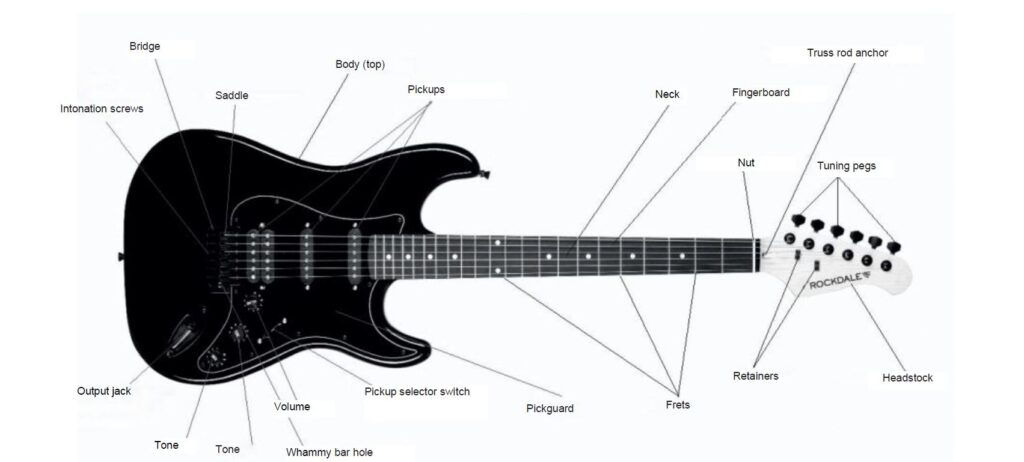
Construction elements
1. Headstock – a structural element of the guitar. It houses the tuning pegs used to adjust the instrument.
2. String retainers – clamping plates that ensure the best string tension on the top nut.
3. Tuning pegs – used to tune the guitar.
4. Truss rod anchor hole – here, using the truss rod, you can adjust the neck relief. The truss rod is a metal insert inside the neck. It serves two purposes: first, it enhances the neck’s strength, and second, it allows you to adjust its relief. Properly tuned guitar necks should have a slight forward bow, similar to the curve of a bowstring, but less noticeable. This correct relief setting is important for preventing string buzzing and maintaining a comfortable string height over the frets. With experience, you can adjust this bow yourself, but for beginners, we recommend having this done by an experienced technician. Instruments sold in stores are roughly set up usually, but we strongly advise having your instrument accurately set up by a professional after purchase. Guitar store sellers often offer this service.
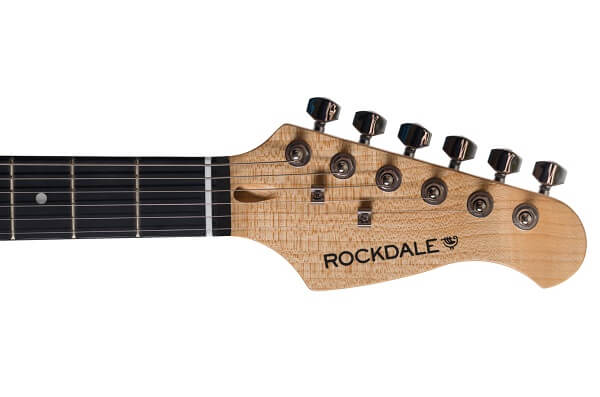
Loosening the string tension is necessary to adjust the truss rod.
5. Neck – a structural element of the guitar. On the neck, the musician presses the strings to produce different notes. When choosing a guitar, it is very important to check the straightness of the neck. A slight bend in the center, as mentioned earlier, is normal. However, bends in other planes, the so-called “twist”, are not acceptable. The neck is commonly made of maple, although other wood species are also used.
6. Fretboard overlay – the fretboard overlay is the working surface of the guitar neck where the frets are located. The material of the fretboard overlay has some influence on the brightness of the sound and comfort during play. Traditional wood species for fretboard overlays include maple, ebony, and rosewood. Rosewood is increasingly being replaced by synthetic or wood-composite materials due to cost and environmental considerations.
There are no definitive recommendations here. Typically, musicians playing music that emphasizes the clean sound of the guitar choose maple. Musicians who enjoy playing with an overdriven sound may opt for rosewood or ebony. However, it’s a matter of personal preference, as each of these materials has its own merits. Your task when choosing an instrument is to ensure that the fretboard overlay is free of cracks, and the frets are not protruding.
7. Frets – frets are metal strips on the guitar neck. The musician presses the strings against the frets while playing the instrument. The sound produced on a string depends on which fret the string is pressed against. The material and height of the frets to some extent influence the comfort of playing. However, for starters, the frets on any quality instrument, even if it’s an entry-level one, should be sufficient.
8. Nut and Saddle – the nut and saddle are crucial elements of a guitar. The distance between them is called the scale length. The accuracy of scale length adjustment determines the correctness of the sound of individual notes and the overall tuning of the guitar. The scale length can vary on different instruments. The most common scale lengths are 25.5″, known as the “Fender” scale, and 24.75″, known as the “Gibson” scale. There are also guitars with a 27″ scale, known as baritones, and multi-scale guitars with fan frets, but these are more uncommon.
In simple terms, the scale length determines the spacing between frets on the neck. While the difference between the “Fender” and “Gibson” scales might not be very noticeable while playing, the baritone scale of 27″ requires more finger stretch, making it less comfortable for playing technically complex solos. However, instruments with such scale lengths produce a denser and lower sound, suitable for powerful rhythm guitar parts. The guitar used as an example in this article has a “Fender” scale of 25.5″.
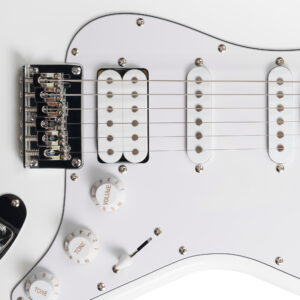
The lower nut in some designs doesn’t appear as a unified nut. In this case, the bridge saddle forms its own individual rear nut for each separate string.
9. Scale length adjustment screws – the scale length adjustment screws allow you to adjust the length of each individual string by moving the saddle (the part on the rear bridge where the string rests) forward or backward. For inexperienced musicians, we recommend entrusting the scale length adjustment to a professional (store seller or guitar technician). Eventually, you will learn to do it yourself, but this skill requires experience.
10. Body (soundboard) – it is common to encounter discussions about the best type of wood for making the body, whether a top is necessary, whether the body should have cavities, and so on. Indeed, different wood species sound somewhat different, and different constructions affect the sound as well. However, at the beginning of your journey as a guitar player, these nuances are not crucial. Firstly, even the same wood species will sound different in different instruments due to a multitude of factors: wood subspecies (there are many species of maple or redwood), the age of the wood, where and in what climate it grew, the drying process, and the residual moisture content in the body, among many other factors. We strongly advise against delving into these complexities at the very start of your electric guitar journey. At the initial stage, the body material will not play a significant role for you.
11. Pickups – understanding this point is crucial for a beginner guitarist, as the choice of the right pickups directly influences whether they can play the music they desire. Pickups are magnetic sensors that capture string vibrations and convert them into electrical impulses. In essence, the pickups’ work allows us to hear the guitar sound, as the body itself resonates very weakly. It is essential to understand that pickups come in two types: single coils (a pickup with one coil) and humbuckers (a pickup with two coils). Single-coils have a softer, more delicate and beautiful sound, with more overtones and depth to it.
Single Coil Pickup:
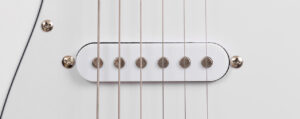
A single coil sounds flatter and sharper, but it is much more powerful and aggressive. However, the most important thing is that due to its structural features, a single coil produces a lot of “noise,” meaning it generates extraneous sounds when playing with overloaded sound, making it practically unsuitable for such purposes. Its path is pure sound, with, at most, a slight overload. If you are a metal fan or want to play solo parts on overloaded sound, even in not-so-heavy music, you need humbuckers.
Humbucker Pickup:
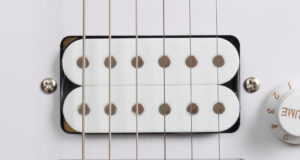
A good choice is the option shown in the photo:
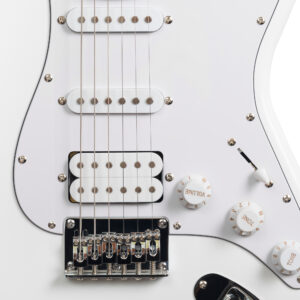
Here you see two single coils in the neck and middle positions (neck is the position near the neck). In the bridge position, there is a humbucker (the bridge position is the position near the rear bridge). To play parts with overloaded sound, you can activate the humbucker, for clean sound play – the single coils. The pickup position also matters a lot. Typically, most rhythm guitar parts are played on the bridge pickup, and solos are played on the neck pickup. But this is determined each time by the nature of the composition.
12. Bridge – the structure that secures the strings at the rear of the guitar. This is another extremely important element to understand before purchasing the instrument. Using the tremolo arm, you can rock the bridge up or down and achieve the distinctive effect of playing with the tremolo (deep vibrato, “dive bombs,” piercing harmonics, etc.).
The bridge of an electric guitar can have different designs and appearances:
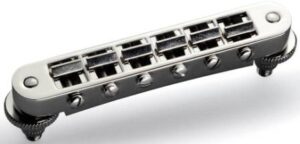
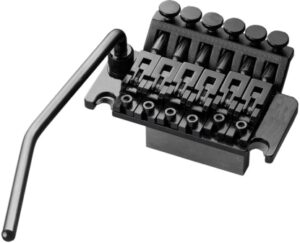
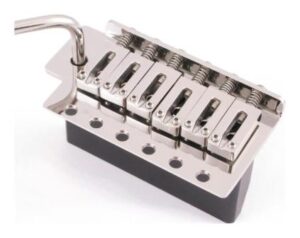
The problem is that the more features a bridge offers, the more complex it is to tune and operate. For example, intricate double-locking bridges like “Floyd Rose” provide maximum possibilities but are also highly temperamental. For a beginner musician, simply tuning an instrument with such a bridge can be daunting, as it essentially hangs in the air, supported by two points (knife edges), balancing tension from the strings on one side and tension from special springs on the other.
When adjusting one string, you alter the tension force on the string side, causing the bridge position to change by a fraction of a millimeter, leading all strings to slightly “pull up” or “dive.” In other words, tuning one string affects the pitch of other strings, which can be a significant problem. The second problem is adjusting the spring tension when changing strings to those from a different manufacturer or a different gauge. The third problem is the change in the bridge position when leaning on it with your hand during play. And there are also the fourth and fifth problems… In any case, we do not recommend choosing a guitar with such a bridge as your first instrument.
A fixed bridge like “tunamatic” is a radical solution to these problems. With it, there are no issues, but there are no additional features either. A guitar with this bridge can be recommended as a first instrument. But what if you are a fan of, for example, Steve Vai? In that case, you can try the classic option (as shown in our first picture). This is a “tremolo” bridge. It allows rocking the tremolo arm only in one direction, downward. Some effects will be unavailable, but most tremolo work is based on downward movement. However, the “tremolo” bridge rests on the body and is secured by six screws on one side, making it much more stable and less finicky in operation.
13. Tremolo arm hole – this is where the tremolo arm is inserted for working with the bridge.
14. Tone knobs – tone knobs adjust the tonal quality for each of the pickups.
15. Volume – the volume knob controls the instrument’s overall loudness.
16. Pickup selector switch – a five-position switch that allows you to choose which pickups are active at any given moment. You can select the operation mode of one pickup or a combination of several. This significantly alters the sound, providing you with broad possibilities to express your musical individuality.
17. Jack socket – the “jack” socket is used to connect the guitar to an amplifier.
Amplifier
Certainly, you are aware that an electric guitar by itself hardly produces audible sound, and to truly hear it, you need to connect it to an amplifier. However, the guitar amplifier is not just a device that makes the sound loud; it essentially creates the sound. In shaping the sound you hear, the amplifier arguably plays an even more significant role than the guitar itself, so choosing one requires careful consideration.
Currently, the market offers amplifiers of all generations, and in this case, belonging to a new generation is by no means a guarantee of better sound. It’s important for the guitarist to understand what kind of amplifier is needed for their tasks. So, let’s move on to practical recommendations.
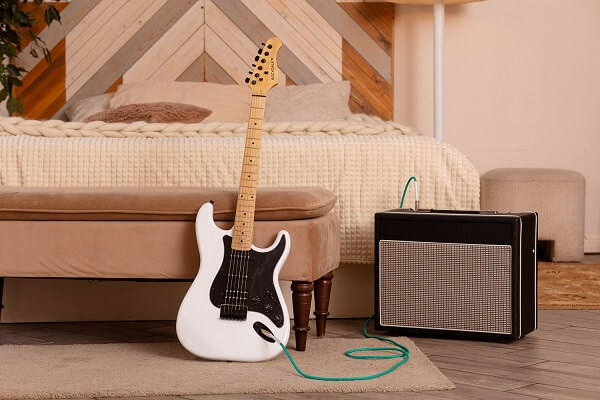
Musical style and amplifier selection
If you want to play music built on the clean sound of the guitar (funk, jazz, country, psychedelic rock, Britpop, etc.), it’s advisable to consider “low-gain” amplifiers. On the other hand, if you are a fan of punk, heavy metal, thrash, metalcore, math-metal, modern metal, death metal, black metal, etc., then your choice would be a “high-gain” amplifier. Of course, modern amplifiers are much more versatile than their predecessors; each of them can to some extent produce both a beautiful clean sound and decent overdrive. However, specialization still exists, so thoroughly researching this aspect before purchasing an amplifier is crucial, as important as the choice of the guitar itself.
Tube amplifiers
Tube amplifiers are a pricey delight. They are great for delivering a maximum “warm” and “authentic” sound. Playing on them can be more challenging, as tubes are unforgiving of the slightest errors in sound extraction. However, if you master playing on a tube amplifier, you truly know how to play! Typically, tube amplifiers have limited effects capabilities. A good clean sound and a good overdriven sound – often, that’s all they can offer. Nevertheless, there is a vast number of enthusiasts for tube amplifiers.
Transistor amplifiers
Transistor amplifiers can be characterized as a transitional period between tube and digital amplifiers. They weigh much less than tube amplifiers, are much less finicky during transport, cost significantly less, and still sound quite good. An excellent choice for a beginner musician.
Digital amplifiers
Digital amplifiers mark a new milestone in the development of civilization. Until recently, digital amplifiers were considered a cheap alternative to a “real” amplifier. The significant advantage of these amplifiers is that one unit can encompass almost the entire spectrum of possible amplifier types and effects. As a result, what would have cost a fortune in analog form a while ago can now be acquired for a relatively modest sum. On the other hand, digital amplifiers are rightly called modeling amplifiers. They model, meaning they attempt to imitate the sound of “real” amplifiers. A decade ago, this was noticeable, but today technology has advanced so far that modeling amplifiers don’t hesitate to emulate even top-tier gear. Firstly, it’s very compact. Secondly, it’s very convenient to set up and manage. Thirdly, it already sounds very good. For a beginner musician, getting a relatively inexpensive modeling amplifier in the form of a combo, where the amplifier is combined with a speaker cabinet, is an excellent choice!
Effects
The third and very extensive topic is the devices for sound processing. As we have already determined, by itself, the electric guitar practically doesn’t produce sound, and when connected to an amplifier, it sounds either similar to a regular acoustic guitar or produces an overdriven sound without any additional effects. However, there are a wide range of options for guitar sound, but to fully realize them, sound processing devices are needed, which in the past were often in the form of pedals that were included in the overall sound chain. By pressing one or several pedals, a guitarist activates the desired effect or combination of effects. Here are the most common effects found in the guitar sound: We have already discussed overdrive effects. It remains to say that depending on the nature of the sound, they are usually divided into Fuzz, Overdrive, and Distortion.
Wah-Wah – a pedal that, when pressed, gives the guitar a characteristic quacking sound. It is extremely popular in heavy styles when playing solos. By changing the position of the pedal in time with the music, you can achieve a very interesting sound.
Chorus – an effect that simulates the sound of multiple guitars playing simultaneously. Typically used with a clean sound, it helps to make the sound richer and deeper.
Reverb/Hall – spatial effects. They create the impression that the guitar is playing in a spacious room with good acoustics and reflections from different surfaces.
Delay/Echo – effects that produce delayed repetitions of the notes, with a tendency to fade out. When properly adjusted, they sound very beautiful.
Flanger – creates a distinctive psychedelic guitar sound. It is similar to chorus but has a specific coloration, which makes it stand out as a separate effect.
Pitch shift/octaver – effects based on changing the pitch of the main tone and mixing it with the original signal. They allow for creating different intervals, producing interesting sounds. The Octaver is a special case of the pitch shifter, creating an interval in the octave, which sounds very stable and harmonious in any situation.
Of course, there are many more guitar effects; we have listed only the most basic ones. The question arises; does a beginner guitarist need to buy a complete set of effect pedals along with the guitar and amplifier? Not at all! Skills on the instrument can be developed using only the guitar and an amplifier with overdrive capabilities (perhaps the only effect that is truly necessary, even for learning, because the playing technique on it is very different from the technique of playing with a clean sound). The second piece of good news is that most modern amplifiers (especially modeling amplifiers) already have all the basic effects on board for convenience.
We hope that our article was helpful for you!